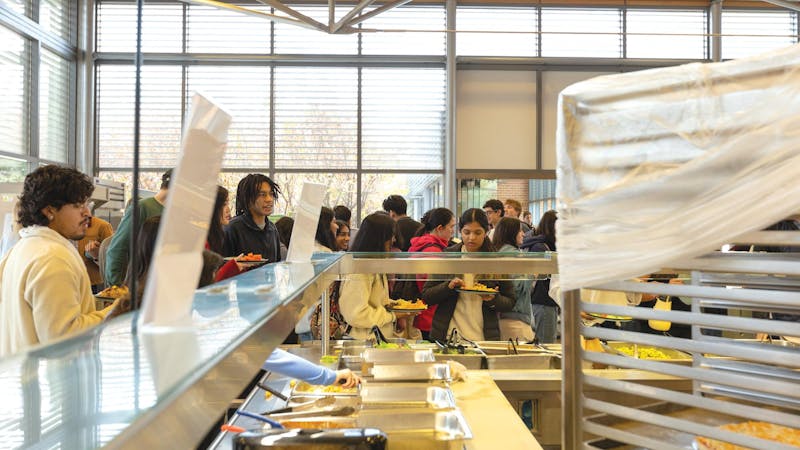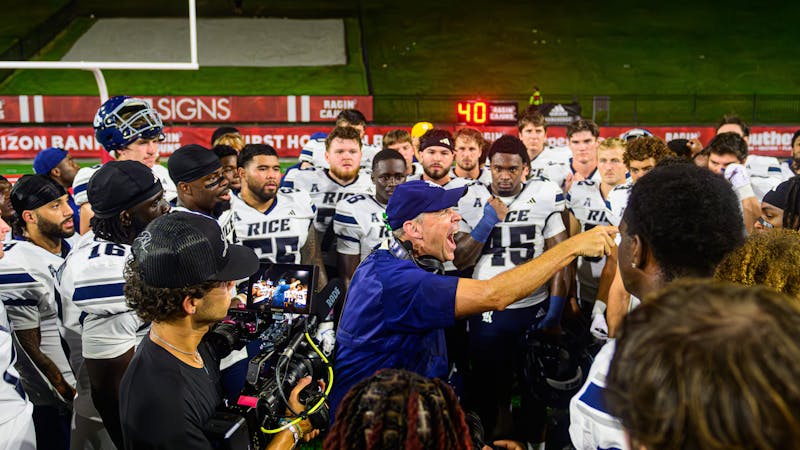Rice's shanty town: from riches to rags

Two dollars will not buy you a latte from the Raymond and Susan Brochstein Pavilion, but it will be the per-diem budget for a group of students next week who will mimic poverty firsthand. In a simulation of Third World shanty towns, dozens of Rice students will be encamped in makeshift housing near Brochstein Pavilion next week. This past summer, students from Engineers Without Borders and Rice MicroFinance tackled logistics for the $2 A Day Challenge, working with a number of administrative organizations: Housing and Dining, Rice University Police Department, Facilities Engineering and Planning and Vice President for Administration Kevin Kirby.
"We've had the administration's full support and they're really excited to see this event happen," EWB President Samantha Teltser said.
Former RMF President Josh Ozer said the event will serve both as a living museum to educate people about poverty and as a fundraiser for the student groups involved.
The Challenge
Teaming up to host the $2 A Day Challenge, EWB and RMF are seeking to increase poverty awareness on campus, as about two billion people across the world live on less than $2 per day.
Nearly 75 students will be living in a temporary shanty town in the Central Quad to simulate poverty in underdeveloped countries. The students will move in Tuesday and stay until dinner on Friday, a total of four days and three nights.
The shanty town will be a collection of individual shanties. The construction committee, co-chaired by Wiess College junior Jeremy Goodreau and Brown College junior Matt Stearns, devised the floor plans for the shanties. Two sizes of shanty will be built - an eight-by-eight structure, which will hold four students, and an eight-by-ten structure, which will hold six students.
Elena White, a Martel College sophomore and president of Owl MicroFinance, a subdivision of RMF, said the shanties will be built mainly out of two-by-fours, some plywood, and cardboard boxes. She said Southland Hardware and Stahlman Lumber Company, both Houston businesses, donated supplies.
"These plans were developed for up to 100 participants," White said. "The number of shanties we build will depend on the final number of participants we have."
The participants will eat three meals per day in the shanty town. Because the students will not be eating in the serveries during the challenge, Teltser, a Will Rice College senior, said H&D agreed to provide rice and beans each day. To bolster the community feeling of the shanty town, she said students will take turns serving the meals and cleaning up after each other.
A living museum
The shanty town will raise awareness about poverty, Ozer, a Will Rice College junior, said, adding that there will be an information desk, a rudimentary medical clinic and student-run tours of the establishment.
Co-President of Humanitarian Medical Outreach Jecca Steinberg said the clinic will mirror what might be found in a real shanty town. It will feature basic supplies - such as a cot, gloves and bandages - collected over the summer by HuMed members from families and local businesses.
"It's going to be more of a museum kind of display," Steinberg, a Brown College junior, said. "The supplies are probably not going to be sanitary and it wouldn't be up to U.S. health code to actually treat our students in a third-world shanty clinic."
Any participating students requiring medical attention, acknowledging concerns about H1N1 flu, will need to go to Student Health Services. Ozer said there will be hand sanitizer at all of the food stations and students will be encouraged to drink more water and get more sleep than they usually would.
The shanty will be open to the general public each day from 12 p.m.-3 p.m. Students living in the shanty town will staff its information desk and give tours during those hours to explain the project, answer questions about poverty in developing countries and give background information on the student groups involved. There will be a collection box at the info desk for visiting Houstonians who wish to contribute to the students' efforts, President of Owl MicroFinance, a subdivision of RMF, Elena White said.
Location, location
Vice President for Administration Kevin Kirby said the steering committee's request to use the Central Quad for the challenge was met with one minor concern.
"[We asked] if they were going to create anything that went into the ground," Kirby said, citing water lines and irrigation systems as possible problems.
However, Kirby said the models the students created did not require any below-ground expansion.
"The students are quite clever and have built a mock-up . without digging holes in the ground," Kirby said. "I'm happy to support something that has been so well thought out."
Ozer said one of the reasons the Central Quad was selected as the shanty town's location is its high visibility.
"Having [the shanty town] in the center of campus will attract a larger audience," Ozer said. "It will allow people, as they stroll from place to place, to prowl through the shanty town."
High foot traffic is not the only reason the steering committee had its eyes on the Central Quad. Teltser said the visual image of a shanty town in front of one of Rice's newest buildings, the Raymond and Susan Brochstein Pavilion, will provide another layer of interest.
"We wanted our shanty town to be juxtaposed with the glass box of modernity," Teltser said.
No more showers
While there will be neither Orwellian shanty town police nor a long list of concrete rules, Teltser said she hopes participants make decisions in "the spirit of the challenge."
Ozer added that he wants the challenge to be a memorable experience that sparks conversation. One of the suggestions, intended to simulate limited access to resources, is for participants to not shower.
"When you smell bad, you have to tell your boss," Ozer said. "That causes you to engage in conversation about the challenge."
Teltser said dinner discussions, games of Frisbee and other communal activities are to be expected to promote shanty town unity. White said the entire Rice community, even those not involved with the challenge, are welcome to take part in the discussions.
"We want this to be an open forum," she said. "We know it's not a perfect situation ... but we want to unite people who care about these issues and open a dialogue."
Both Teltser and Ozer said that while they want students to spend as much time as possible in the shanty town, academic responsibilities will take precedence. There will not be penalties for having to go to Fondren Library to complete schoolwork, Teltser said, though they are encouraging students to restrict laptop and cell phone usage while in the shanty town. Still, Ozer said that no one will be evicted from the shanty town for checking their e-mail.
"It's not so much about, 'You broke a rule; you're done,'" Ozer said.
However, one rule that will be enforced in the shanty town is the strict no alcohol policy, Teltser said. Additionally, the Rice University Police Department will patrol the area more frequently than usual, Kirby said.
Ozer said the challenge will bring students of similar interests together in a unique setting in an unprecented way.
"To get this many students together and plan a show of solidarity like this .is something on that scale, we haven't really seen at Rice before," Ozer said.
Kirby said he hopes the challenge will increase student activism on campus.
"I think [poverty] is an important social issue and [the shanty town] will add a lot of vibrancy of campus life," Kirby said.
Emily Morian-Lozano, a Will Rice College senior and project participant, said the shanty town will be something that draws everyone's attention.
"[This] is one of the first instances of activism I've seen on campus," she said.
Though the challenge will focus on raising awareness of a salient social issue, it will also be a fundraiser. Participants must raise at least $30 in donations, though White said $75 per person is the goal amount. Part of that money will go towards funding the $2 per day it will cost each student to live there; the rest will go to one of the involved student organizations, at the participant's discretion.
Morian-Lozano said it is important to want to take care of others instead of focusing on making money.
"At college it's easy to get stuck in our own world," she said. "But it's important to remember that there are people who live without knowing when they are going to eat or if they will have water.
More from The Rice Thresher

Over 1,000 students petition against new meal plan
When Konstantin Savvon opened the Housing and Dining email announcing the new unlimited meal plan, he was instantly concerned about the impact on off-campus students like himself.

Rice football wins season opener under new coach
For the first time since 2018, Rice football opened its season with a victory. Scott Abell was soaked with yellow Powerade following a 14-12 win on the road Saturday against the University of Louisiana at Lafayette, which won 10 games and made it to the Sun Belt Conference championship last season.

Acting like an athlete: Rice basketball alum takes on Broadway
Underneath Chadd Alexander’s Broadway costume, there’s ankle tape and wrist braces — same protective gear he wore as a walk-on basketball player at Rice, though now he’s performing eight shows a week in the ensemble of “Harry Potter and the Cursed Child” instead of running conditioning drills in Tudor Fieldhouse.

Please note All comments are eligible for publication by The Rice Thresher.